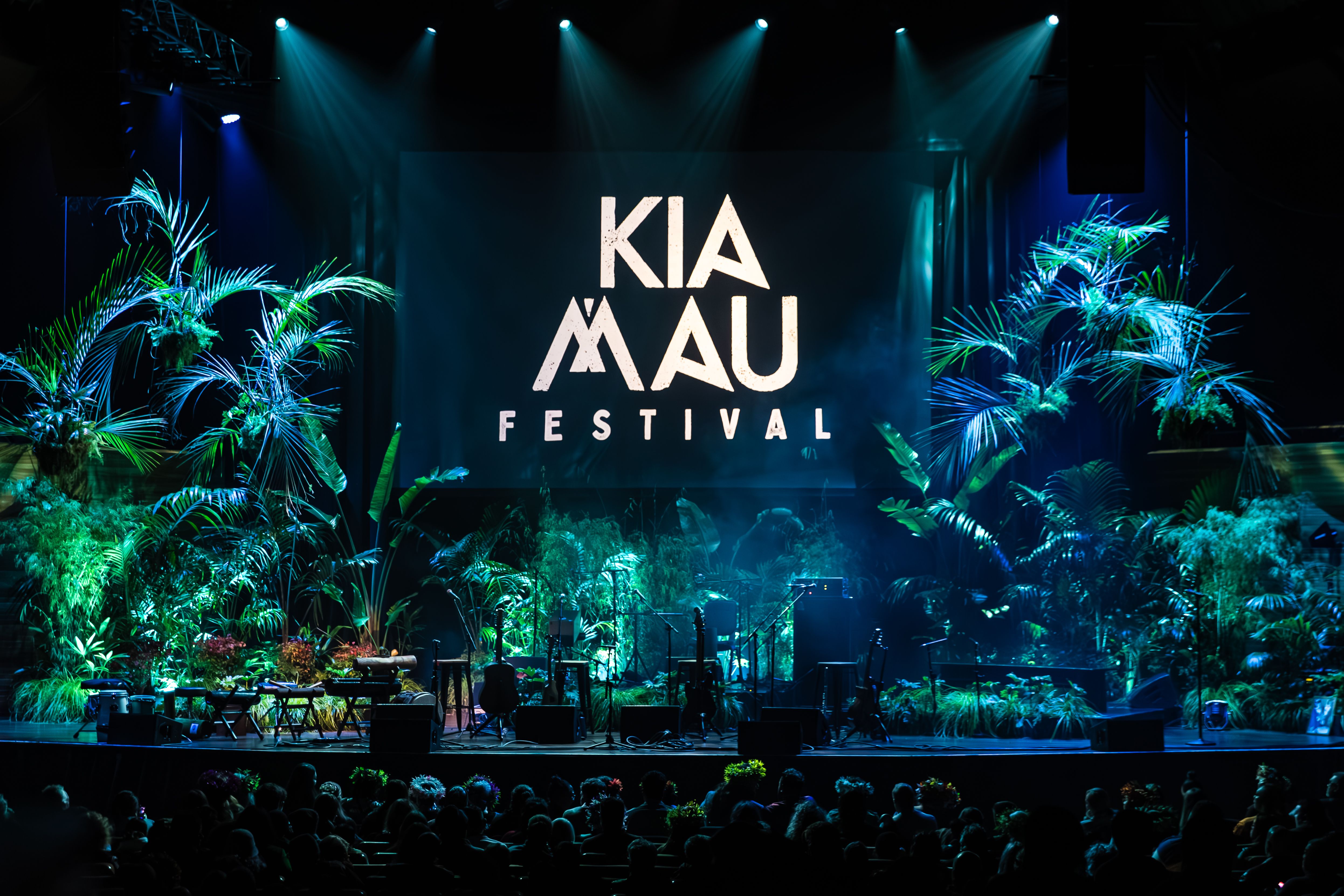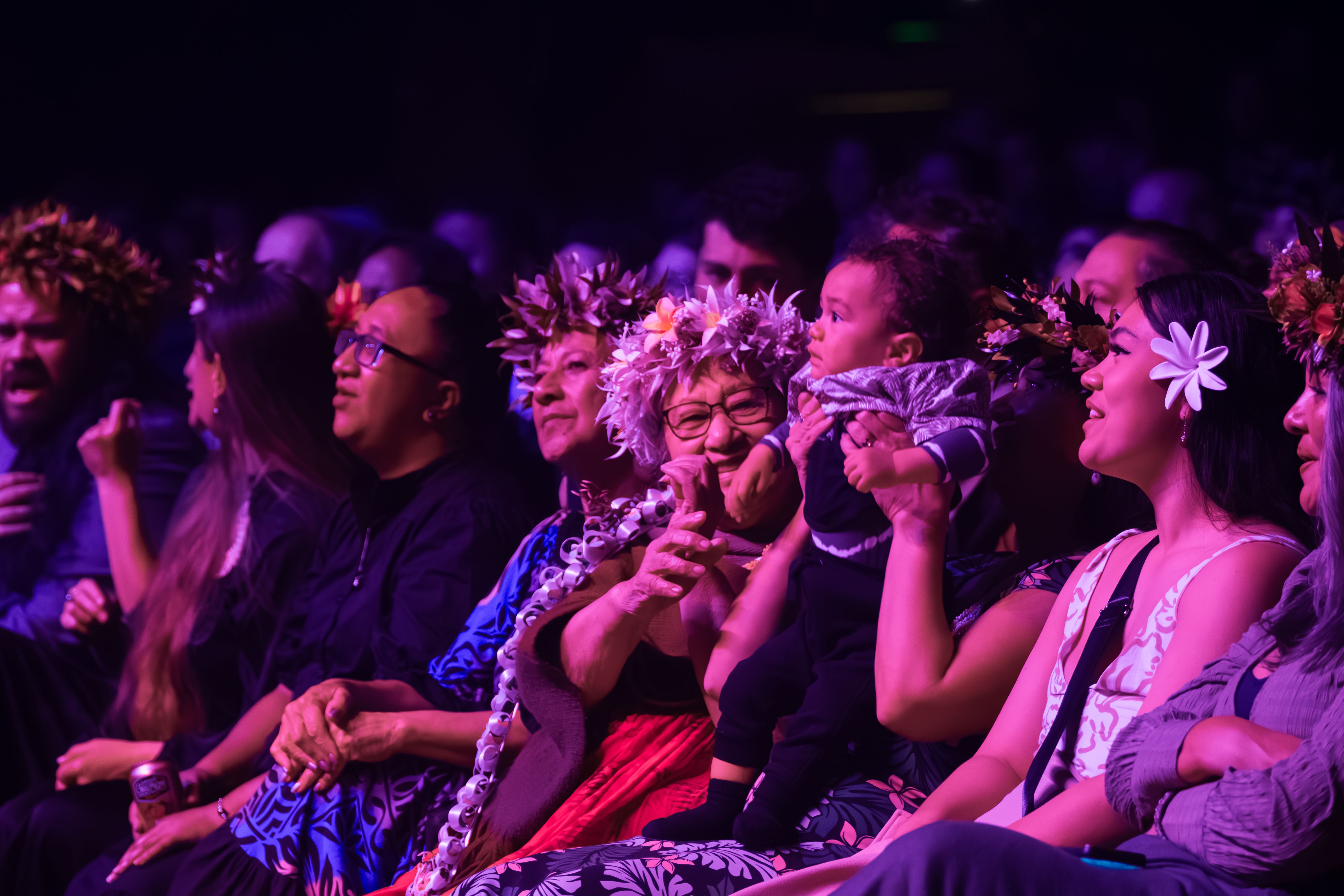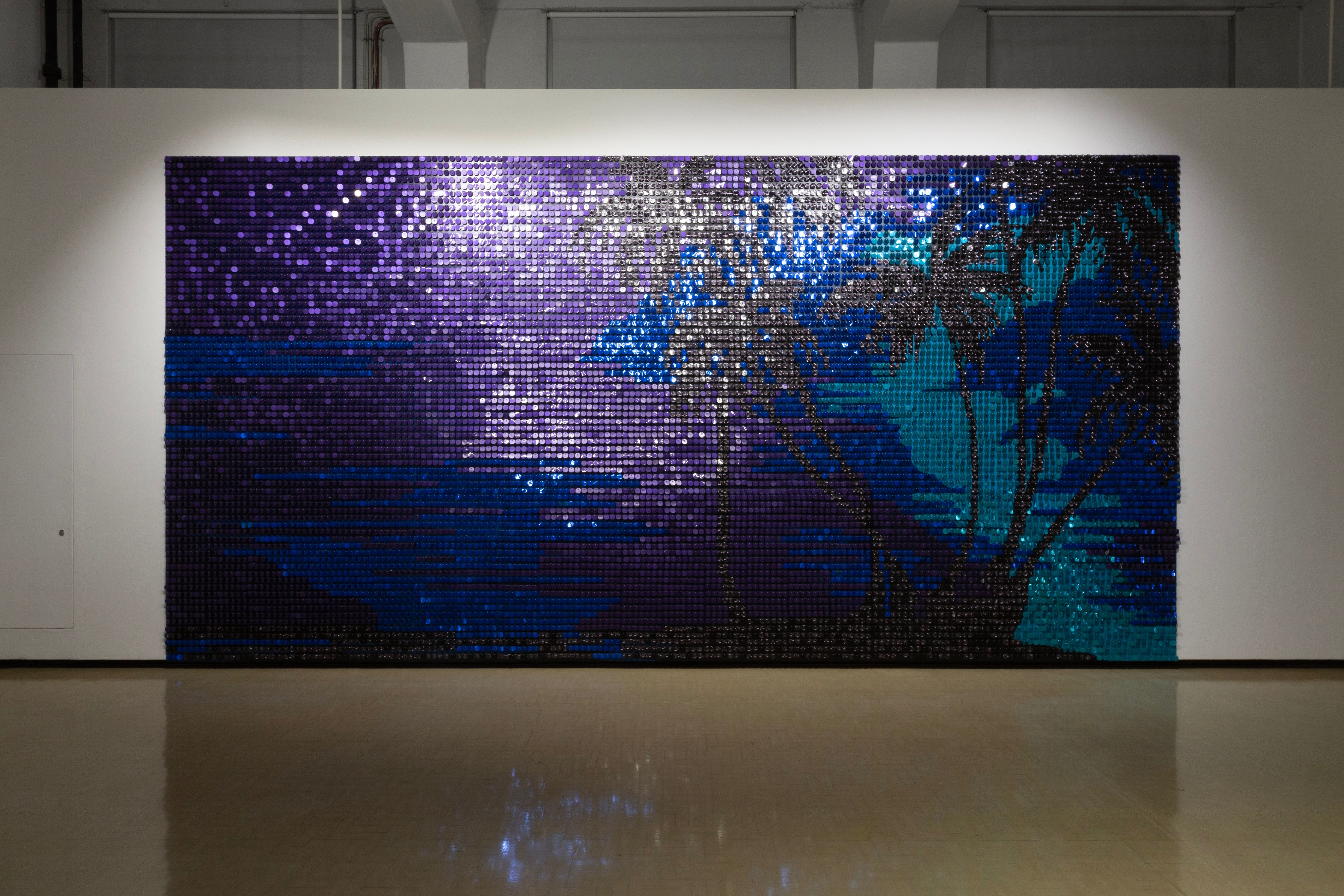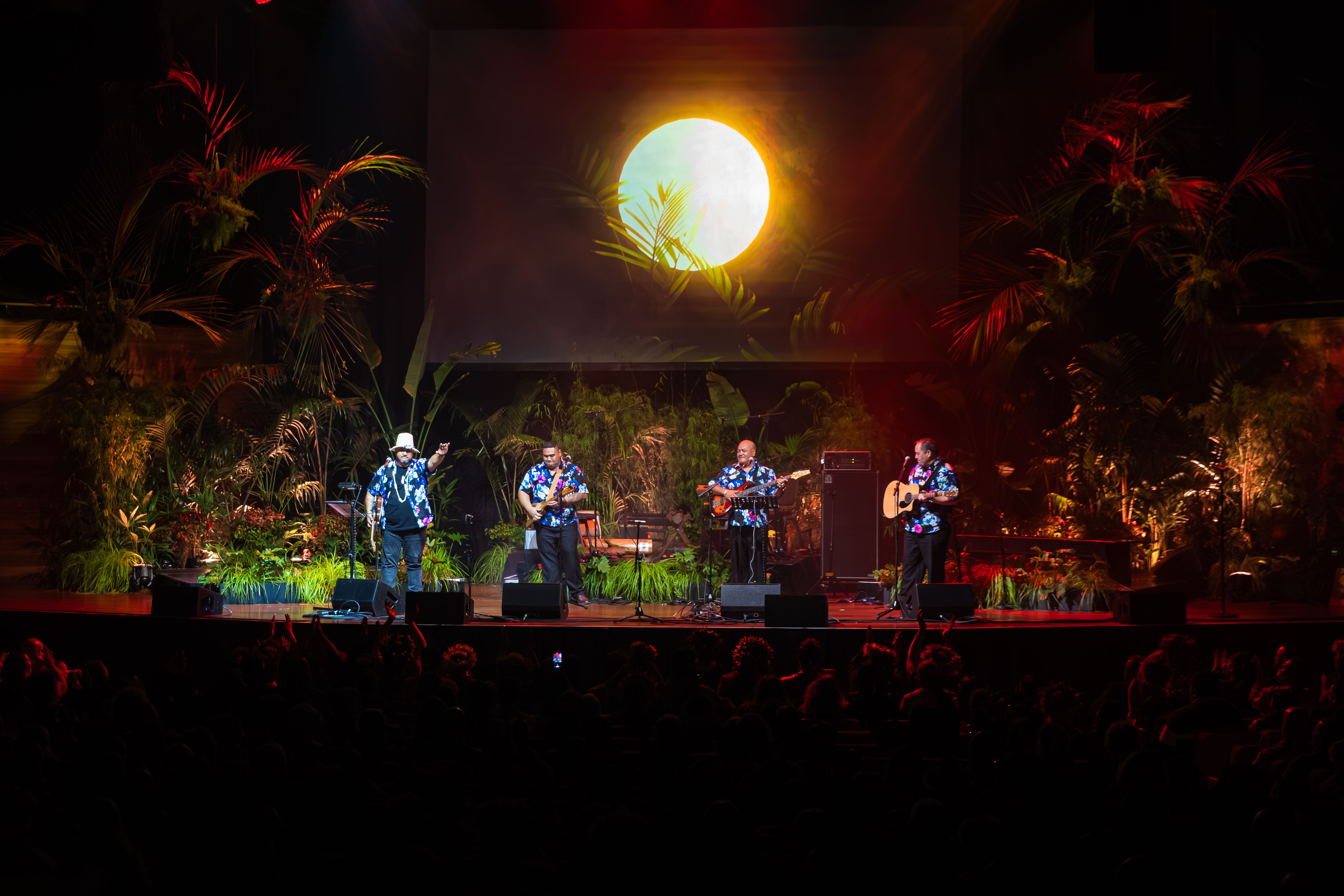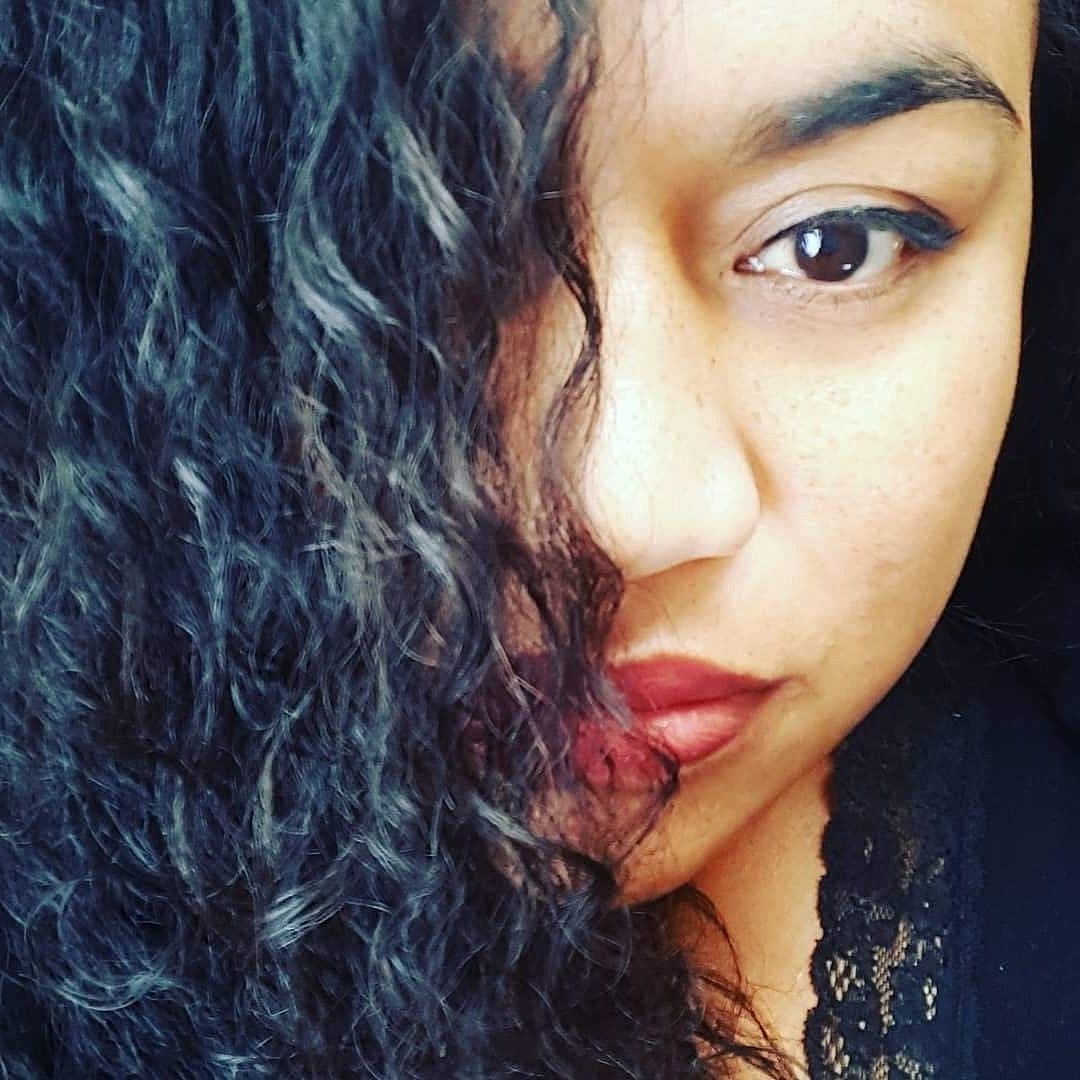'Avaiki Nui Social Review
Tamara Tulitua reviews 'Avaiki Nui Social, a lush celebration of musical history from across Te Moana Nui a Kiva.
‘Avaiki Nui Social showcased Kuki Airani string bands through the decades. Storytellers Tuaratini and Jarcinda Stowers-Ama wove together iconic musicians, including Faipoto Aporo, Pania Apolo, Tupou Apolo, Jarome, Brother Love and Ardijah, with the artistry of production director Mīria George, filmmakers The Raro Dog and choreographer Te Hau Winitana.
Kuki Airani mamas selling ‘ei katu were a welcome relief from the abrasive Pōneke wind at our backs. We made our way to the stalls, found them lush with island flora on shirts and dresses, ‘ei katu, laughs, catch-ups – all signals that the show would be far more than just what was written in the programme. We sat close to the stage and glanced back – bobbing ‘ei katu reminded me of flowers drifting on the moana currents as if their gorgeousness is made to float across space, spilling their sweet fragrance across borders. Verdant greenery layered the stage set from floor to ceiling. Abstract palm trees bordered the stage right and left, and a large screen at the centre held the Kia Mau Festival branding.
Photo credit: Roc+ Photography
Tuaratini, our journey guide, enters stage right, looking regal from her ‘ei katu-crowned head to her long vivid skirt and shining black pearl strings. She calls out “‘Avaiki Nui!”, warm and inviting. We prepare for a journey through the decades as we follow the lineage of Kuki Airani string bands. She traces the ukulele ancestry to the machete, which was invented in Portugal and introduced to the Cook Islands via Hawai‘i in the late 1800s. Since then, the ukulele has been a mainstay of their musical landscape, in particular the string bands specific to Kuki Airani. We will start in the 1960s and 1970s, finding our way to the contemporary scene.
But first, a roll call of what she terms “the droplets in Te Moana Nui o Kiva”, the 15 islands of ‘Avaiki Nui: Penrhyn, Rakahanga, Manihiki, Pukapuka, Nassau, Suwarrow, Palmerston, Aitutaki, Manuae, Takutea, Mitiaro, Atiu, Mauke, Rarotonga, Mangaia. Each island is repped in the stalls, each droplet carrying an ocean of pride. Tuaratini sets the tone for a more fluid show – blurring the lines between audience and performers, welcoming call and response, spontaneity, sing-alongs and a jam-sesh mentality with an acoustic flair. It’s on.
String band The Wanderers have been waiting patiently as Tuaratini opens the show. They sit in a semicircle, centre stage, ukulele players and drummers in matching shirts, except for the youngest drummer in customary clothing of feathers, pandanus leaves and shells. Their diffident presence is almost subsumed by the elaborate stage set and soft lighting. This is dispelled the moment Tuaratini cues their set; the band erupts into the full drumming sound of the Cook Islands, the crowd cheers, the vibes stay high. I expect the youngest to dance, then introduce dancers – but he doesn’t. After the first numbers, he jumps up, does a short heralding call, then re-joins the band. They move into old-school tunes. I catch sight of mamas and papas to my left, gleaming, singing along. A young mother two rows ahead rocks a baby on her shoulder. The crowd is as diverse as a plane trip to the islands: a mix of locals, returning diaspora, tourists, mamas, papas and children, all with the common goal of escaping to the islands.
Photo credit: Roc+ Photography
In the lead-up to the show, Rarotongan imagery had been on my mind. As I settle into ‘Avaiki Nui Social, I think of Reuben Paterson’s When the Sun Rises and the Shadows Flee (2005), a response to his time spent in Rarotonga. Recently exhibited at City Gallery Wellington Te Whare Toi, this piece was created using large shimmer discs hanging from a curtain to create an image of island nightfall: silhouetted palms, black land dominated by ocean, and sky of violet and shades of blue. I loved the blurring of the horizon and moana; the overlay of supersized shimmer discs, giving the entire work a rippling shine that echoed the reflection of moon and stars on the moana. An electric fan provided the night breeze. The tawny gallery floor reflected the glistening purple and blue.
The work had me thinking about the dance between the romanticised image of the islands and the true ethereal power of our homelands. Our islands have been overly exoticised since the first fountain pen struck paper, and the work felt like a reclamation of Pacific imagery. The size of the work dominated an entire gallery wall, its reflection beautifying the weathered gallery floor. The work took up space and then some.
The curtain of shimmer discs reminds me of Pasifika adaptation of materials when we can’t source the real tropical item due to distance or limited supply. I think of the myriad ways our Pasifika cultures fold in the synthetic or new to replace, conserve or enhance the native: money for fine mats in some cultural ceremonies; plastic flowers and seeds in ‘ei katu, ula, lei; and imitation tortoiseshell jewellery adorning our bodies. As we move through the decades of string band history, I marvel at the adaptation of the ukulele. This is native adaptation, native joy, native flow. Different types of ukulele – coconut, electric, wooden – are on show, the players insouciant in their skill, the singers passionate in their delivery. Across its journey through Cook Islands history, the ukulele string band has adapted and embraced change through drum machines and foreign musical genres. We can take large shimmer discs, place them carefully where we want them, and make them all shine in a way that is entirely our own.
Reuben Paterson When the Sun Rises and the Shadows Flee 2005, shimmer disks and acrylic on board. Courtesy Dunedin Public Art Gallery. Photo:Cheska Brown
The reflection of Paterson’s work on the gallery floor rippled with gorgeousness. The physical reflection of the work felt intentional: a statement of presence, and power. It was a work whose luminosity refused to be contained. During ‘Avaiki Nui Social, as each band plays their set, audience members spontaneously sashay down the aisles to the front of the stage to dance. There are no dancers on stage, but always in the audience. The singing, dancing audience is the scintillating reflection of the string bands. Pasifika beauty reverberates in our stories passed through music, expressed in movement, wave after inevitable wave. The show is at once a celebration of local music of these island droplets and the affirmation of Cook Island Māori language, dance, stories: a culture thriving to a thrumming beat.
As I said to my whānau the next morning, you had to be there – to see the digital backdrop of the repeated frangipani motif, larger than life, subtly swaying to the music. You had to be there to see Jarome Pare’s delight as four of his whānau floated to the front of the stage and surprised him with choreo to his latest release. To see how, when the band strummed the opening chords to ‘Ruketekete Te Mamae/Have You Ever Loved a Woman’, Brother Love (an understated superstar in sharkies) looked super chill as the audience jumped to their feet, crowded the front of the stage, and sang as one. How the AV display was a full moon and silhouette fronds, and the Kabin Bread Boyz reminded us why romance is spelt i-s-l-a-n-d-v-i-b-e-s. How when Jarome sang the chorus “my echo, self and me”, even the heartbroken decided you can only ura under the stars until the sun rises over your heart again. Or the way that the crowd were at their loudest getting down to the poly funk acoustic set of Ardijah hits, ‘Watchin’ U’ and ‘Silly Love Songs’.
Tuaratini narrated the history of each decade, and announced each return to the stage with the call “‘Avaiki Nui!”, and with a new wardrobe change. The audience cheered at each new fit accessorised with glorious pearls and resplendent ‘ei katu. Kuki sisters have style!
Photo credit: Roc+ Photography
Dramatic interludes that featured Taungaroa Emile, Poe Tiare Tararo, Teherenui Koteka and Roy Iro were a surprising shift in pace. The sketches echoed the themes of the songs – love, belonging and memory. They moved from humour to poetry and incantation in Cook Island Māori. As a non-speaker, I found rich meaning in the performance carrying these words. I was moved by the sketch of a young woman calling her family in the islands. The audience laughed as the younger family members wilfully let the phone ring. Her father answered, ecstatic to hear his daughter’s voice. He said it had been a long time since she had visited home, the hanging silence heavy with all the obstacles, longing and perhaps the challenges she cannot word to her father – some burdens cannot fit through the phone cable. These sketches felt like love letters to the elders: costumes of the 1960s, reflecting the elders as coy young lovers; calls home to the islands when toll call charges ran high, as did the airfares, making both only attainable every other month or year.
The show was meticulously woven with narration, band sets, dramatic sketches and AV displays. It was initially incredible to me that dancers were not part of the programme; however, the first set confirmed that the crowd would be the dancers for the night. Spontaneous dance is a given of any function or event, from the garage to the church hall to the community centre, and, it turned out, the Michael Fowler Centre. The breeze of the ukulele strings gathered flowers from the audience until they landed in swaying grace and beauty at the front of the stage. Song by song, the joy multiplied. Each lead singer paid homage to the pioneers who were present and those who were not – playing both their originals and covers of the greats. Ardijah had the entire crowd on their feet to ‘Moonlighting’, and then all of us chanted “one more song!”, to which they responded with the Prince Tui Teka classic, ‘E Ipo’.
But the memory that has stayed with me is Jarome singing Brother Love’s ‘Aitutaki My Paradise’ as a line of a dozen dancers from the audience ura in impromptu unison. The audience sang at full volume, and by the end of the first verse the line of dancers had arrived from across the stalls, and had settled on their choreography of a few elegant moves. It was a mutual serenade, a celebration of a lush musical history from which flowed a myriad of memories.
This piece is presented as part of a partnership with Kia Mau Festival. Kia Mau have supported the costs of paying our writers while we retain all editorial control.

